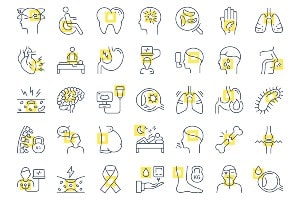About False Labor (Braxton Hicks Contractions)

Learn about the disease, illness and/or condition False Labor (Braxton Hicks Contractions) including: symptoms, causes, treatments, contraindications and conditions at ClusterMed.info.
False Labor (Braxton Hicks Contractions)

| False Labor (Braxton Hicks Contractions) |
|---|
False Labor (Braxton Hicks Contractions) InformationBraxton Hicks contractions facts
What are Braxton Hicks contractions?Braxton-Hicks contractions are contractions of the uterus that occur during the third trimester of pregnancy. They are perfectly normal and have been said to represent contractions that occur as the uterus is preparing to give birth. In some women, they occur as early as the second trimester. Sometimes, Braxton-Hicks contractions have been referred to as "false labor."In contrast to the contractions of true labor, Braxton-Hicks contractions do not occur at regular intervals, do not get stronger over time, and do not last longer over time. They do not occur at predictable intervals, and they may disappear altogether for a time. They tend to become more frequent toward the end of pregnancy.Common events can sometimes trigger Braxton-Hicks contractions, such as increased activity of mother or baby, touching of the maternal abdomen, dehydration, sexual intercourse, or a distended maternal bladder.Braxton-Hicks contractions are named after an English doctor, John Braxton Hicks, who described them in 1872. What can be done if Braxton Hicks contractions are uncomfortable?There are measures that can be taken to bring about relief if Braxton-Hicks contractions are uncomfortable:
;What do Braxton Hicks contractions feel like?Braxton-Hicks contractions are not typically as painful as those of true labor contractions may be. Some women describe them as a tightening sensation across the lower abdomen. They may feel similar to menstrual cramps in some women. The abdomen may become firm to the touch. They do not occur at regular intervals. When should I call my doctor about Braxton Hicks contractions?Call your doctor or midwife if you haven't reached 37 weeks and the contractions are increasing in frequency, are more painful or you have any of the signs of preterm labor:
|
More Diseases
A | B | C | D | E | F | G | H | I | J | K | L | M | N | O | P | Q | R | S | T | U | V | W | X | Y | Z
Diseases & Illnesses Definitions Of The Day
- Noncancerous Colloid Thyroid Nodule (Thyroid Nodules) ‐ How are thyroid nodules diagnosed?, Introduction to thyroid nodules …
- Skin, Laser Resurfacing (Laser Resurfacing) ‐ CO2 Laser Resurfacing, Complications of Laser Skin Resurfacing …
- Malignant Fibrous Histiocytoma (Bone Cancer Overview) ‐ Are there any treatments or medications that relieve bone cancer pain? …
- Double Vision ‐ Is it possible to prevent double vision?, What are the symptoms and signs of double vision? …
- Ageusia (Taste Disorders) ‐ Are taste disorders serious?, Can taste disorders be treated? …
- Autism Screening and Diagnosis ‐
- Alpha-fetoprotein Blood Test ‐ In which situations are high blood (serum) levels of AFP used as a tumor marker? …
- Polymyalgia Rheumatica ‐ How do health care professionals make a diagnosis of polymyalgia rheumatica? …
- Stump Appendicitis (Appendicitis) ‐ Appendicitis definition and facts, Are there long-term consequences of appendectomy? …
- Gonorrhea (Gonorrhea In Women) ‐ Gonorrhea facts, How is gonorrhea diagnosed?, What are sexually transmitted diseases (STDs)? …